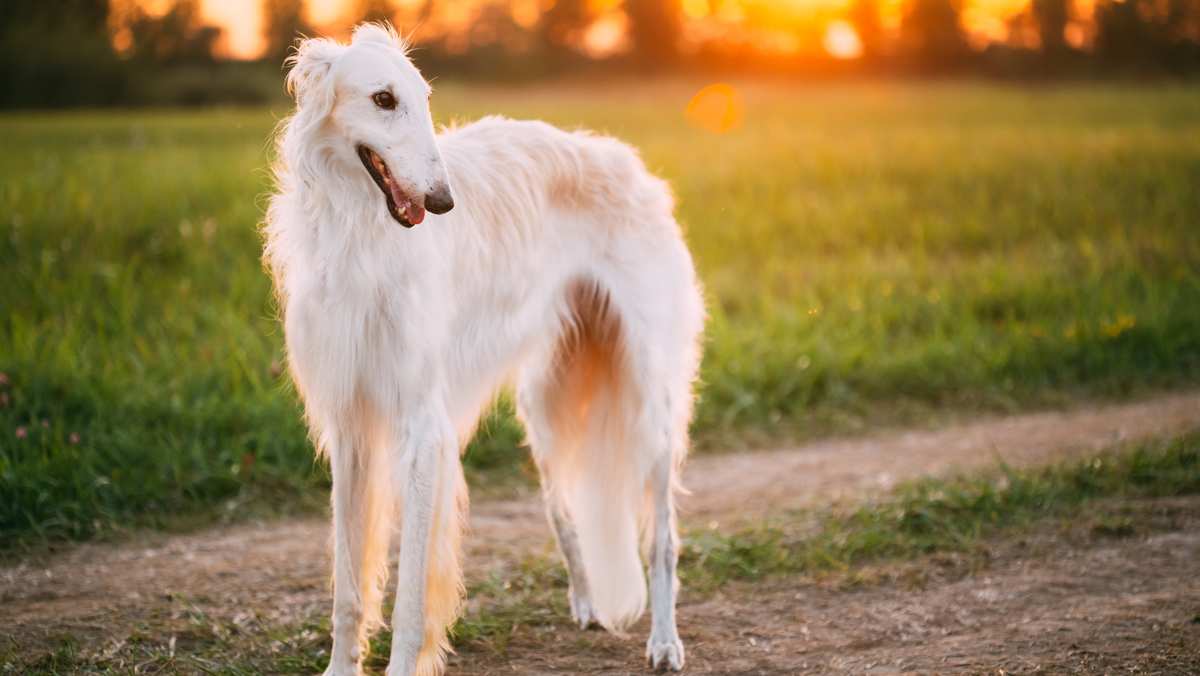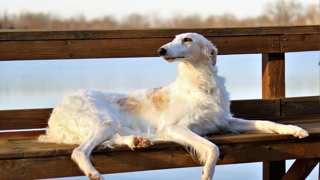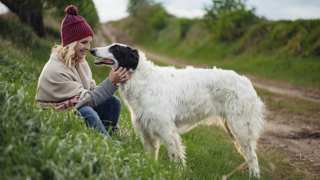Barzoi
Psovoi
Psowaya Barsaya
Russian Borzoi Dog
Russian Hound
Russian Hunting Sighthound
Russian Wolfhound
Russkaya Psovaya Borzaya
The Borzoi is a large purebred dog that originated in Russia. The breed resembles a long-haired greyhound and it is not uncommon for males to exceed 100 pounds in adulthood. Despite the breed's size and weight, they are one of the fastest dog breeds. A healthy Borzoi can reach a top speed of 36-38 mph, which may come as no surprise since Borzoi directly translated means "fast".
Borzoi are independent dogs and rarely bark. The breed makes an excellent indoor dog as they are naturally respectful towards people and prefer lying on a cushion than barking at the mailman through the window. Borzoi do well with pets, but have a strong coursing instinct which makes it difficult for them to resist the urge to non-aggressively chase and pin other animals to the ground.
The Borzoi is a royal Russian sighthound originating in the 17th century. Many factors make the Borzoi unique and interesting. It is among the fastest breeds, reaching speeds of 30-40 miles per hour when chasing their target. This breed have been His behavior is exactly what you'd expect from such an elegant canine. Borzoi are affectionate and active but not to any extreme, making them an excellent choice for almost any household not looking for a needy lap dog. From sportsmen to monarchs, from actresses to authors-- once your fall in love with the Borzoi, you will be forever theirs. Consider the following Borzoi facts to decide if this eye catching hound is right for you:
PROS
- Elegant, graceful, eye-catching
- Quiet, rarely barks
- Calm and agreeable as an adult
- Moderately affectionate, loyal and protective
- Self sufficient, not needy
- Moderately active, good for active individuals
- Good choice for families
- Adaptable to virtually any living space
- Can live in cooler climates
- One of the fastest dogs
- Can get along with small pets if raised with them
- Rich history, dog of royalty
- Excellent sighthound
CONS
- Long coat sheds frequently, not hypoallergenic
- Requires daily brushing
- Rowdy as a puppy, long puppy stage
- Training may be difficult, said to be stubborn
- Needs daily outdoor exercise
- Must always be kept on leash when not in an enclosed area
- High hunting drive, prey instinct
- May chase, hurt small creatures they are unfamiliar with
- Very large size may pose accidental hazard to small children
- Doesn't tolerate rough play
- Reserved around strangers
Note that these pros and cons might not be the same for all owners. For instance, a pet that needs daily outdoor exercise and daily brushing might be too much for one owner but another may consider that no problem.
Purebred
10 - 12 yrs.
26 - 32 in.
75 - 105 lbs
OverallFamily FriendlyChild FriendlyPet FriendlyStranger Friendly
Easy to GroomEnergy LevelExercise NeedsHealthShedding Amount
Barks / HowlsEasy to TrainGuard DogPlayfulnessWatch Dog
Apartment DogCan be AloneGood for Busy OwnersGood for New OwnersIntelligence
Moderately affectionate and active, the Borzoi is an above average choice for most households. They may not be super clingy and affectionate but they are very loyal and are capable of conducting themselves well while you are away at work or school. Adaptable is a Borzoi's middle name-- she can live in an apartment, house, outdoors as long as she gets enough exercise and her daily brushing. The breed is relatively rare in the United States, however, it is popular enough to be featured on an episode of Animal Planet Dog's 101: Borzoi which is a good 4 minute summary of the basics of the breed.
The Borzoi is an excellent choice for an active person or family, however, they are still a good choice for anyone that has enough time to ensure they get their daily outdoor time (and a thorough brushing). Borzoi are good with children due to their calm, agreeable nature but do not enjoy rough play; it's important to teach small children how to respectfully play with your pet. They may be affectionate and loyal towards their family but will likely remain reserved with strangers. Other dogs should get along quite well with this pack dog but it's not a great idea to introduce a cat into the mix unless the Borzoi is raise with it from puppyhood.
Borzoi require a moderate amount of exercise. Although they won't hesitate to go on an adventure with you, a few long walks or daily playtime in a fenced yard will keep them happy and relaxed. When they are puppies, however, they will likely need more vigorous exercise to burn off that rambunctious puppy energy. Make sure your Borzoi remains on leash unless in a fenced area. He/she will have a strong instinct to hunt small creatures they will not hesitate to run off to do so. If you haven't seen a Borzoi running, you're in for a treat-- their elegant, graceful frames can gallop up to 35-40 mph! It's also important to note this breed is not easy to train; they are often described as stubborn and independent requiring a patient handler.
The Russian Borzoi dog, known as the Russian Wolfhound prior to 1936, was bred by Russian aristocracy during the 1600s for the purpose of hunting wolves, foxes and hare. Arabian Greyhounds were introduced to Russia during this time as a hunting companion for noblemen, however, the thin coat resulted in the early death of many of these dogs in the cold, icy terrain. The Arabian Greyhound and Russian Sheepdog (or similar woolly breed) were then crossed to create a long-haired, fast and powerful sight hound-- in fact, Borzoi basically translates to "swift" in Russian. Note that another, less popular theory postulated by Mr. Joseph B. Thomas insisted the Borzoi evolved from dogs Native to Northern Russia. The first standard was written in 1650 and from their conception these dogs would hunt in massive packs (over 100 canines according to the AKC). Books published in Moscow in 1892 divided the Borzoi into several subtypes based on physical features such as the shape of the ears or the length and texture of the coat, however, no great variations really existed.
The breed made it to America as the 19th century came to a close (around 1890). They were brought over from England where they had been introduced as gifts from Russian royalty to Queen Victoria during the early 1800s. The breed was recognized by the AKC almost immediately after in 1891. Another notable fact is that a great number of Borzois were slaughtered in Russian during the revolution due to their association with the Russian czars and other nobility and elite. Luckily, the breed survived and became quite popular during the 1920's-1930's in America. The Romanoff Kennels produced several winning show dogs and the breed was a favorite of several famous Hollywood actresses of the era-- even the captain of the Titanic owned a Russian Wolfhound. In 1936 the name was officially changed to 'Borzoi'.
If we try to define the Russian Borzoi's looks, this dog is often referred to as elegant, graceful and athletic. They have the stereotypical sight hound shape-- powerful, lean muscle over a thin frame giving their body a sloping, streamlined look. The Borzoi skull is their most recognizable feature aside from the coat. The long, narrow Borzoi head has hardly any stop between the forehead and muzzle-- meaning the face looks flat when viewed from the front. The eyes are typically dark brown and are set towards the sides of the head giving them a wide range of vision. The ears are small and lay back towards the neck only standing upright when something peaks their attention. A lean muscled neck leads into sloping shoulders and long, straight forelegs. A Borzoi's chest is very deep and their hind legs very long and powerful.
The coat of the Borzoi is always long and can be wavy or curly as well as straight. There is no standard color or combination of colors for this breed. Feathering of the coat is present on the chest, back of the legs and on the tail. Note there should also be an excess of fur around the neck and in the spot the coat is often curly.
The images below represent the coat colors and patterns associated with Borzoi.
The Borzoi breed doesn't include much variation. Perhaps the coat is the only feature in which variation is common. First, there is no standard color(s) for the Borzoi so the coat can be any color or combination of colors. Also, the coat can be either straight, wavy or curly. Regardless of the texture this is a long-haired breed; short haired Borzois are not at all standard and if you see one, he/she has either had the coat cut or the individual is not a purebred.
Additionally, some breeders will cross smaller breeds with the Borzoi to create miniature Borzois. They often use another type of sight hound, such as the Whippet for these crosses. In this case, the resulting hybrid has the size of the Whippet while still looking quite similar to the Borzoi.
The Borzoi temperament is one of moderation-- they are moderately active and moderately affectionate. Although they are very loyal and responsive, they are often described as "cat-like" due to their quiet, independent characteristics. Also, members of this breed require a very patient owner when it comes to training as they are stubborn and quite rambunctious during puppyhood. The Borzois personality lends itself well to single owners and families alike, although children should be taught not to roughhouse with them. Besides the fact that they don't like rough play their large size presents an accidental hazard to small children-- a giant Borzoi in play mode could easily knock over a small child. With early socialization they are typically not overly shy towards strangers but may still be reluctant to interact.
Borzois go through a notoriously long puppy stage where they can be hyper and destructive if not given enough stimulation. Daily walks and early training are musts! What they may lack in ease of training they make up for in adaptability; Borzois are quiet, not overly active and can enjoy many different types of living arrangements. The breed is not prone to separation anxiety. They do appreciate an active owner and will be quite happy with moderate exercise and daily time outdoors to stretch their long legs.
Owning a Borzoi can be a very attractive option for owners seeking a elegant, head turning pet, however, there are a few requirements to be considered before choosing this breed. First, Borzoi may be quiet and self-sufficient but they still need daily outdoor exercise. They are especially energetic in their (longer than average) puppy stage and providing daily walks or playtime in a fenced area is very helpful in preventing destructive behaviors resulting from a bored puppy. Speaking of fences, potential owner should seriously consider having a fenced yard so their Borzoi can run freely; otherwise members of this breed should not be allowed off leash due to their high hunting instincts! Such a speedy canine can be out of your reach in the blink of an eye.
Borzoi are very adaptable and can do well in apartments as well as homes with yards provided they get daily exercise. They are typically independent and quiet while indoors, only barking when necessary. You can generally find them curled up on a soft blanket or pillow. Those with pet allergies should note that Borzoi are not hypoallergenic and, as a long haired breed, do shed quite a bit. Daily brushing is recommended-- only 5 minutes per day can reduce shed and keep the coat healthy and beautiful.
Your Borzoi will likely live 9-10 years but it is not unheard of for some individuals to live up to 12-14 years, according to the Borzoi Club of America. Although this lifespan is rather long for a giant breed, they are still prone to a few health issues and are genetically predisposed to a few more. The most common concerns for your Borzoi hound are:
- Bloat is common is large-sized, deep chested dogs. This stomach twisting movement can be caused by eating too much or too fast--and it can be fatal.
- Dental Disease is very common and can result in damage to major organs.
- Joint Problems such as osteochondritis dissecans, patellar luxation, and hip and elbow dysplasia and are often hereditary but can also be caused by growing (gaining weight) too fast.
- Sensitivity to anesthesia
- Thyroid disorders
- Heart defects
Keep in mind that is not certain your Borzoi will acquire or inherit any condition from this list.
If purchasing a Borzoi hound from a breeder, doing your research to make sure he/she is reputable and responsible is the #1 way to ensure a healthy puppy. There are a few easy preventative measures you can do at home. Feed your Borzoi at least 2 times per day instead of at one large meal as this will help prevent bloat. Brush his/her teeth regularly to prevent dental disease. Finally, brush/comb the coat daily with a firm bristle brush to keep the hair and skin clean and healthy.
Below are potential health concerns associated with Borzoi.
Bloat
Hip dysplasia
Patellar luxation
Elbow dysplasia
Osteochondritis Dissecans
Dental problems
Heart problems
Thyroid disorders
Sensitivity to anesthesia






